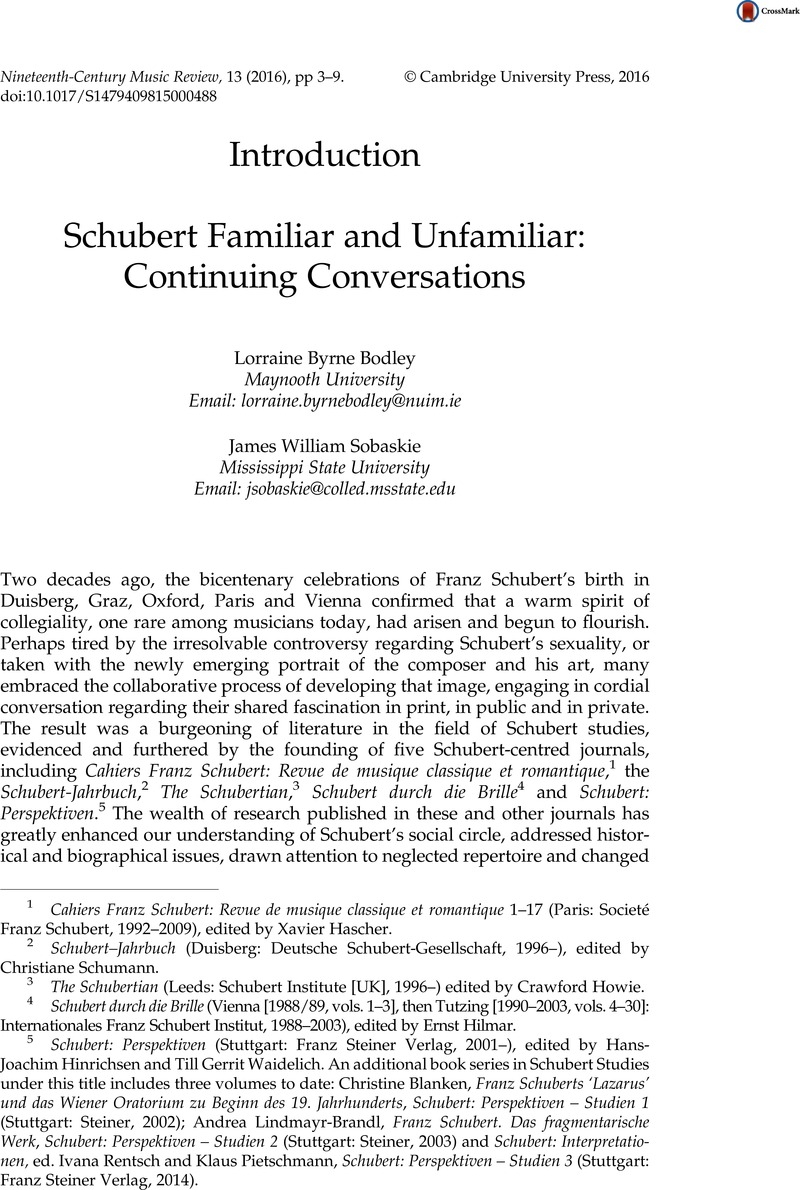Article contents
Schubert Familiar and Unfamiliar: Continuing Conversations
Published online by Cambridge University Press: 04 April 2016
Abstract

- Type
- Introduction
- Information
- Copyright
- © Cambridge University Press 2016
References
1 Cahiers Franz Schubert: Revue de musique classique et romantique 1–17 (Paris: Societé Franz Schubert, 1992–2009), edited by Xavier Hascher.
2 Schubert–Jahrbuch (Duisberg: Deutsche Schubert-Gesellschaft, 1996–), edited by Christiane Schumann.
3 The Schubertian (Leeds: Schubert Institute [UK], 1996–) edited by Crawford Howie.
4 Schubert durch die Brille (Vienna [1988/89, vols. 1–3], then Tutzing [1990–2003, vols. 4–30]: Internationales Franz Schubert Institut, 1988–2003), edited by Ernst Hilmar.
5 Schubert: Perspektiven (Stuttgart: Franz Steiner Verlag, 2001–), edited by Hans-Joachim Hinrichsen and Till Gerrit Waidelich. An additional book series in Schubert Studies under this title includes three volumes to date: Blanken, Christine, Franz Schuberts ‘Lazarus’ und das Wiener Oratorium zu Beginn des 19. Jahrhunderts, Schubert: Perspektiven – Studien 1 (Stuttgart: Steiner, 2002)Google Scholar; Lindmayr-Brandl, Andrea, Franz Schubert. Das fragmentarische Werk, Schubert: Perspektiven – Studien 2 (Stuttgart: Steiner, 2003)Google Scholar and Schubert: Interpretationen, ed. Rentsch, Ivana and Pietschmann, Klaus, Schubert: Perspektiven – Studien 3 (Stuttgart: Franz Steiner Verlag, 2014)Google Scholar.
6 Numerous monographs and anthologies also have addressed these topics, including: The Cambridge Companion to Schubert, ed. Christopher H. Gibbs (Cambridge: Cambridge University Press, 1997); Steblin, Rita, Die Unsinnsgesellschaft: Franz Schubert, Leopold Kupelwieser und ihr Freundeskreis (Vienna: Böhlau Verlag, 1998)Google Scholar; Schubert the Progressive: History, Performance Practice, Analysis, ed. Brian Newbould (Aldershot: Ashgate, 2003); and Le style instrumental de Schubert: Sources, analyse, évolution, ed. Xavier Hascher (Paris: Publications de la Sorbonne, 2007).
7 Dahlhaus, Carl, ‘Die Sonatenform bei Schubert: Der Erste Satz des G-dur-Quartetts D. 887’, Musica 32 (1978)Google Scholar, trans. Reinhard, Thilo as ‘Sonata Form in Schubert: The First Movement of the G major String Quartet, Op. 161 (D. 877)’ in Walter Frisch, ed., Schubert: Critical and Analytical Studies (Lincoln, NB: University of Nebraska Press, 1986): 13–30 Google Scholar; Hinrichsen, Hans-Joachim, Untersuchungen zur Entwicklung der Sonatenform in der Instrumentalmusik Franz Schubert (Tutzing, 1994)Google Scholar; Hascher, Xavier, Schubert, la forme sonate et son evolution (Bern: Peter Lang, 1996)Google Scholar; Hascher, Xavier, Symbole et fantasme dans l’adagio du Quintette de Schubert (Paris: L’Harmattan, 2005)Google Scholar.
8 Sly, Gordon, ‘Schubert’s Innovations in Sonata Form: Compositional Logic and Structural Interpretation’, Journal of Music Theory 45 (2001): 119–150 CrossRefGoogle Scholar; Burnham, Scott, ‘Landscape as Music, Landscape as Truth: Schubert and the Burden of Repetition’, 19th-Century Music 29/1 (2005): 31–41 CrossRefGoogle Scholar; Mak, Su Yin, ‘Schubert’s Sonata Forms and the Poetics of the Lyric’, Journal of Musicology 23/2 (2006): 263–306 CrossRefGoogle Scholar, Mak, Su Yin, Schubert’s Lyricism Reconsidered: Structure, Design and Rhetoric (Saarbrücken: Lambert, 2010)Google Scholar; Fisk, Charles, Returning Cycles: Contexts for the Interpretation of Schubert’s Impromptus and Last Sonatas (Berkeley and Los Angeles: University of California Press, 2001)CrossRefGoogle Scholar; Hyland, Anne M., ‘The “Tightened Bow”: Analysing the Juxtaposition of Drama and Lyricism in Schubert’s Paratactic Sonata-form Movements’, in Irish Musical Analysis (Irish Musical Studies vol. 11), ed. Gareth Cox and Julian Horton (Dublin: Four Courts Press, 2014): 17–40 Google Scholar.
9 Music Analysis 33/2 (2014), ‘Special Issue: Schubert’s String Quintet’, edited by William Drabkin, featured four articles, including John Martin and Steven Vande Moortele, ‘Formal Functions and Retrospective Reinterpretation in the First Movement of Schubert’s String Quintet (pp. 130–55), Scott Burnham, ‘Thresholds Between, Worlds Apart’ (pp. 156–67), ‘Timeless Reflections: Form, Cadence and Tonal Structure in the Scherzo and Finale of Schubert’s String Quintet’ (pp. 168–93), and ‘Stasis and Continuity in Schubert’s String Quintet: Responses to Nathan Martin, Steven Vande Moortele, Scott Burnham and John Koslovsky’ (pp. 194–213).
10 Lewin, David, ‘ Auf dem Flusse: Image and Background in a Schubert Song’, 19th-Century Music 6 (1982–83): 47–59 CrossRefGoogle Scholar; Cohn, Richard, ‘“As Wonderful as Star Clusters”: Instruments for Gazing at Tonality in Schubert’, 19th-Century Music 22 (1998): 9–40 Google Scholar; Clark, Suzannah, Analyzing Schubert (Cambridge: Cambridge University Press, 2011)CrossRefGoogle Scholar; Damschroder, David, Harmony in Schubert (Cambridge: Cambridge University Press, 2010)Google Scholar; Lewin, David, David Lewin’s Morgengruß, ed. David Bard-Schwarz and Richard Cohn (Oxford: Oxford University Press, 2015)Google Scholar.
11 Wollenberg, Susan, Schubert’s Fingerprints: Studies in the Instrumental Works (Farnham: Ashgate, 2011)Google Scholar.
12 Hatten, Robert, Interpreting Musical Gestures, Topics and Tropes (Bloomington: Indiana University Press, 2004): 53–68 Google Scholar and 177–200.
13 Youens, Susan, Retracing a Winter’s Journey: Schubert’s Winterreise (Ithaca, New York, Cornell University Press, 1991)Google Scholar; Hugo Wolf: The Vocal Music (Princeton; Princeton University Press, 1992); Franz Schubert: Die schöne Müllerin (Cambridge: Cambridge University Press, 1992); Schubert’s Poets and the Making of Lieder (Cambridge: Cambridge University Press, 1996); Schubert, Müller and Die schöne Müllerin (Cambridge: Cambridge University Press, 1997); Hugo Wolf and his Mörike Songs (Cambridge: Cambridge University Press, 2000); Schubert’s Late Lieder: Beyond the Song Cycles (Cambridge: Cambridge University Press, 2002); Heine and the Lied (Cambridge: Cambridge University Press, 2007).
14 Johnson, Graham, Franz Schubert: The Complete Songs, 3 vols (London and New Haven: Yale University Press, 2014)Google Scholar. See the review of this book elsewhere in this issue.
15 See, for example, Schubert, Franz, Neue Ausgabe sämtlicher Werke, Lieder IV, vols 1–14 (1970–2011) and Kritische Berichte, vols 1–14 (1972–2014); Walther Dürr, Michael Kube, Uwe Schweikert, Stefanie Steiner (eds), Schubert-Liedlexikon (Kassel et al: Bärenreiter Verlag, 2012)Google Scholar.
16 Graham Johnson, Franz Schubert. The Complete Songs 40 CDs (Hyperion Edition, CDS44201/40). See its comprehensive review in Nineteenth-Century Music Review 5/2: 123–64.
17 President of the Internationale Schubert-Gesellschaft, Prof. Thomas Seedorf with editorial board members Dr Rudolf Faber, Dr Michael Kube and Dr Christine Martin.
18 Schubert’s Late Music: History, Theory, Style (Cambridge: Cambridge University Press, forthcoming 2016) and Rethinking Schubert (Oxford: Oxford University Press, forthcoming 2016).
19 Christiane Schumann, Schubert-Jahrbuch 2010–13, vol. 1 (Kassel: Bärenreiter-Verlag, 2014). A further notable example is the Deutsche Schubert-Gesellschaft 25-Year Jubilee celebrations which took place on 7 November 2014 at which addresses were given by Walther Dürr, Thomas Seedorf and Olaf Bär.
20 Gibbs, Christopher and Solvik, Morton, Franz Schubert and his World (Princeton: Princeton University Press, 2014)CrossRefGoogle Scholar.
- 1
- Cited by





